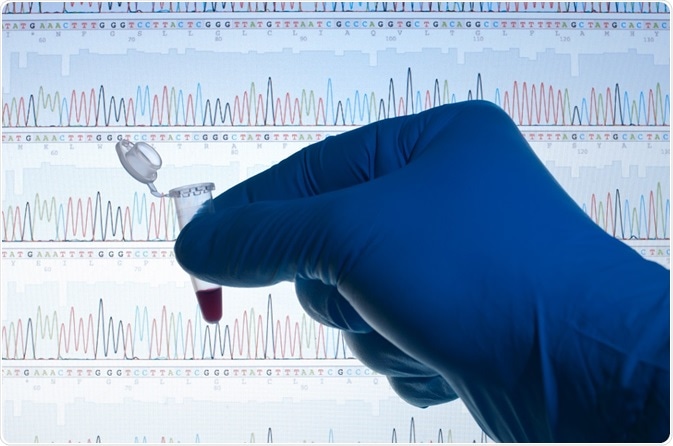Satellite DNA consists of arrays of tandemly repeating sequences that are widely present (>30%) in the genome.
 Credit: dameru/Shutterstock.com
Credit: dameru/Shutterstock.com
Satellite DNA is mainly present in heterochromatin or the tightly packed regions of chromosomes in centromeres, telomeres, and sometimes even in the euchromatin region (active region of the genome). Although conventionally satellite DNA has been known to be ‘non-coding’ (i.e. it does not encode protein), recent evidence suggests that some of the satellite DNA does undergo transcription.
Satellite DNA structure
Satellite DNA consists of arrays of tandem repeats or repeats arranged side-by-side. These repeats can be as small as 1−2 bp long or as long as 10−60 bps long. The short tandem repeats (1-2 bp long) are called microsatellite or simple sequence repeats (SSRs), while the longer tandem repeats (10-60bp long) are called minisatellites or variable number tandem repeats (VNTRs).
The regions in between two simple sequence repeats or microsatellite are termed as ‘inter simple sequence repeats’ or ISSRs. Due to the presence of large number of repeats, the mutation rate is high in satellite DNA. It is speculated that as most of these sequences do not code for proteins, the detrimental consequences of high mutation rate is low. Thus, there is no selection pressure against it.
Why is it called ‘satellite DNA’?
The density of DNA can be calculated using density gradient centrifugation. When a DNA containing solution is spun at very high rotational speed, amoxil 400mg DNA sediments in the tube in a density-dependent manner. When the density of DNA was determined in this manner, it was found that satellite DNA formed a second ‘satellite’ band separate from the rest of the DNA.
The density of DNA is a function of its base and sequence, and satellite DNA with its highly repetitive DNA has a reduced or a characteristic density compared to the rest of the genome. Thus, the name ‘satellite DNA’ was coined.
Functions of satellite DNA
Although popularly satellite DNA is thought to be part of ‘junk DNA’ or ‘selfish DNA’ which occupy the genome but have no effect on the fitness of an organism, recent studies show several distinct biological functions.
- They reside in the centromeric and pericentrometric regions and regulate centromere function.
- They are involved in the formation of heterochromatin. Periodic A-T distribution leads to the curvature of DNA, and satellite DNA with its AT-rich regions is considered to be important for packing of DNA in heterochromatin region.
- Transcripts of satellite RNA have been found in invertebrates, vertebrates, and plants where they are transcribed at a particular developmental stage in certain cells and tissues.
As the sequences of satellite DNA are highly diverse and variable, sequence-specific regulatory signals are speculated to be present in satellite DNA which fine tune gene expression
Applications
The short sequences of DNA stretches in satellite DNA vary from individual to individual. These variations in the length and sequence of satellite DNA are unique to each individual.
This uniqueness can be exploited to identify each individual based on their DNA map. This technique is called DNA fingerprinting, and it is used to identify criminals, perform paternity tests, and diagnose genetic disorders.
Sources:
- Manuel A. Garrido-Ramos, “Satellite DNA: An Evolving Topic.” Genes (Basel). 2017 Sep 18;8(9)
- L. Bachmann, M. Raab, J. Schibel, and D. Sperlich, “Satellite DNA,” in Molecular Techniques in Taxonomy, Berlin, Heidelberg: Springer Berlin Heidelberg, 1991, pp. 133–143.
- G. C. S. Kuhn, “‘Satellite DNA transcripts have diverse biological roles in Drosophila,’” Hered. 2015 1151, Mar. 2015.
- D. Ugarkovic, “Functional elements residing within satellite DNAs.,” EMBO Rep., vol. 6, no. 11, pp. 1035–9, Nov. 2005.
Further Reading
- All DNA Content
- What is DNA?
- DNA Properties
- DNA Chemical Modifications
- DNA Biological Functions
Last Updated: Feb 26, 2019

Written by
Dr. Surat P
Dr. Surat graduated with a Ph.D. in Cell Biology and Mechanobiology from the Tata Institute of Fundamental Research (Mumbai, India) in 2016. Prior to her Ph.D., Surat studied for a Bachelor of Science (B.Sc.) degree in Zoology, during which she was the recipient of anIndian Academy of SciencesSummer Fellowship to study the proteins involved in AIDs. She produces feature articles on a wide range of topics, such as medical ethics, data manipulation, pseudoscience and superstition, education, and human evolution. She is passionate about science communication and writes articles covering all areas of the life sciences.
Source: Read Full Article
